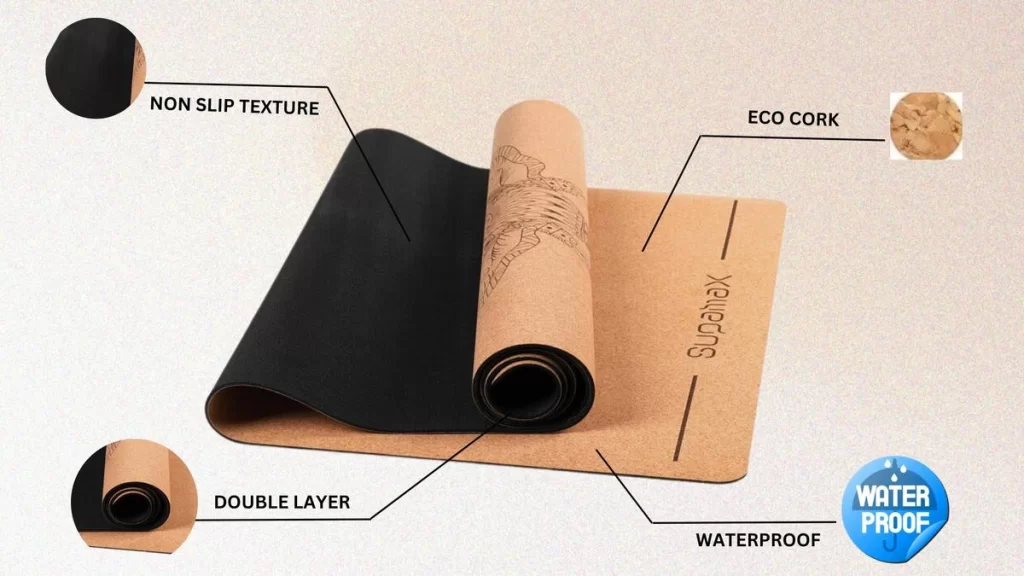Cork Yoga Mat vs Rubber Yoga Mat: Unraveling the Best Yoga Mat Type for Your Practice
In the pursuit of enhancing your yoga practice, choosing the perfect mat can make all the difference. This article delves into the comparison of cork yoga mats and rubber yoga mats, shedding light on their characteristics, benefits, and considerations. If you are grappling with the decision of cork vs rubber, this piece offers insights that can help you make an informed choice, ensuring your mat complements your yoga journey effectively.

Choosing a yoga mat goes beyond just picking the first one you see. The material of the mat plays a pivotal role in enhancing or impeding your yoga practice. Cork and rubber yoga mats have emerged as popular choices, each offering a distinct set of advantages.
What Makes a Cork Yoga Mat Special?
Cork is a natural material harvested from the bark of cork oak trees. This renewable resource offers a plethora of benefits, making cork yoga mats a favorite among eco-conscious yogis. Cork yoga mats are known for their natural antimicrobial properties, providing a clean surface for practice. Additionally, they offer good grip, especially beneficial for those practicing hot yoga, as they tend not to become slippery when you sweat.

The process of harvesting cork is environmentally friendly. Cork oak trees are not cut down; instead, the bark is stripped, allowing the tree to continue growing and re-producing bark, making it a sustainably sourced material.
Delving into Rubber Yoga Mats
Rubber yoga mats tend to be made from either natural rubber or synthetic rubber. Natural rubber mats are often eco-friendly and provide good traction, making them suitable for various yoga practices. Rubber mats also tend to be more durable, with many yoga mats on the market being able to last for several years with proper care.
However, it is essential to note that while natural rubber yoga mats are good for the environment, synthetic rubber mats, made from plastic and rubber polymers, may not be as eco-friendly.
PVC and TPE Yoga Mats: A Glimpse
PVC yoga mats are a common choice among yogis, known for their durability and low cost. However, they are not biodegradable and can be harmful to the environment. On the other hand, TPE (Thermoplastic Elastomers) yoga mats are a more eco-friendly alternative, offering similar durability and cost-effectiveness. When comparing PVC and TPE to cork and rubber, it is crucial to weigh the environmental impact alongside other considerations such as grip and lifespan.
Cork vs Rubber: A Comprehensive Comparison
When comparing cork and rubber yoga mats, several factors come into play. Cork mats are known for their good grip, especially during hot yoga classes, and their natural antimicrobial properties. They are also sustainably sourced, with cork oak trees being able to regenerate bark.
Rubber mats, on the other hand, offer excellent traction and are typically more durable. Natural rubber yoga mats are eco-friendly, but the same cannot be said for mats made from synthetic rubber. When water is spilled on the mat, rubber mats tend to offer better grip compared to cork mats.
What Do Yogis Prefer?
Many yogis have varying preferences when it comes to choosing a yoga mat. Some prefer the natural feel and benefits of cork, while others opt for the durability and traction offered by rubber mats. Observations in yoga studios reveal a mix of both cork and rubber mats, reflecting the diverse needs and preferences of the yoga community.
How to Choose the Right Mat for Your Practice
Choosing the right mat depends on the type of yoga you practice, your environmental considerations, and personal preferences. If you practice hot yoga, a cork mat might be more suitable due to its good grip when wet. However, if durability and traction are your priorities, a rubber mat might be the better option.
It’s also essential to consider when you’ll need to replace your mat. Mats made of cork or natural rubber tend to last longer, but once they begin to show signs of wear, it might be time to invest in a new yoga mat.
- Consider your main style of yoga. More cushioning works well for restorative and yin yoga while a firmer surface suits vinyasa flows.
- Try it out in-person if possible to check the amount of padding and grip. Online reviews from verified buyers also help assess quality.
- Look for an eco-friendly, non-toxic material if sustainability is important to you.
- Make sure it fits your height when lying down, with extra room for your hands above your head.
- Choose a thickness to suit your joint sensitivity and cushioning needs.
- Grippy texture prevents slipping, especially for hot yoga when sweaty.
- Expect to pay $70 to $100+ for good quality that lasts, especially with cork mats.
Caring for Your Yoga Mat
Proper cleaning and maintenance are crucial to ensuring your mat lasts as long as possible. Whether it’s a cork or rubber mat, regular cleaning helps maintain its properties and prevent the accumulation of dirt and bacteria. Moreover, proper care can extend the lifespan of the mat, reducing the need to replace it as often.
Eco-Friendly Alternatives and Innovations
The yoga community is becoming increasingly eco-conscious, leading to the development of more eco-friendly yoga products. Innovations in yoga mat materials continue to emerge, aiming to provide sustainable options without compromising on quality and functionality.
Concluding Thoughts and Recommendations
Both cork and rubber yoga mats have their merits and drawbacks. Cork mats offer excellent grip, natural antimicrobial properties, and are sustainably sourced. Rubber mats are known for their durability, traction, and, in the case of natural rubber, their eco-friendliness.
Before purchasing, ponder on your individual needs, practice, and environmental considerations. Whether you choose cork or rubber, ensuring that the mat aligns with your yoga journey is paramount.






